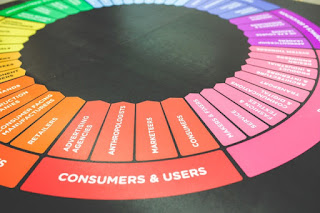Marketing has changed significantly in the past ten or fifteen years due to digital channels and more services versus products. This impacts not just what expertise or qualifications lecturer, teacher or tutor needs, but how marketing is taught in the classroom and coursebooks used e.g. inclusion of relevant digital content and a change in concepts. Digital communication technology leverages word of mouth and horizontal communication while precluding control of messages.
Following is an introductory summary to teaching marketing round digital concepts in the classroom:
‘Digital offerings represent different challenges for marketers than do traditional goods and services. After reviewing the literature, the authors suggest ways that the marketing of dd services might be better presented to and better understood by students……. The authors also present specific suggestions for assignments and class discussions to foster students’ critical thinking about the marketing implications surrounding digital offerings.
When the U.S. economy shifted away from its manufacturing base, services marketing theory arose to help marketers deal with the unique nature of the increasingly intangible offerings (Berry 1980).
More recently, the economy has shifted again, driven by digital technologies. Not only have products been digitized, but information and communication technologies have also made it possible to distance producers from consumers, both in space and time. Marketing practice has responded to this environmental change, but academic marketing thinking has not come as far.
We first became aware of the problem while teaching MBA students concentrating in digital media management. For their marketing management course, we used Kotler and Keller’s (2009) Marketing Management. Kotler’s work has arguably been one of the central repositories of marketing’s received theories and ideas. We quickly realized, however, that the discussion of the digital offerings that these students were so engaged with (film, music, and video games) was lacking……
…..How has the marketing discipline responded? Our purpose here is not to suggest that there has been a dearth of literature about the impact of digital technology but rather that there are significant gaps in the literature about how to address digital offerings conceptually….What is missing, however , are pedagogical proposals for teaching about the challenges of marketing digital offerings.
The need to fill this gap comes not only from marketing practice, but also from accrediting bodies.
The 2013 Association to Advance Collegiate Schools of Business (AACSB) standards man date that business programs include learning experiences that help students understand the integration of information technology in business…. Clearly, it is time to equip our students with tools for understanding and embracing all things digital. And it is time to equip faculty with the tools to do so. Faculty are faced with students for whom digital offerings are pervasive, yet who need to learn how to market those offerings strategically…..
Many traditional offerings have become available digitally including maps, tax preparation, customer service, reference sources, higher education, and distance medical consulting….. when applying the IHIP framework to digital offerings, some significant differences arise, both in terms of the features of the offerings as well as the attendant marketing challenges…..
Digital technologies have become ubiquitous in marketing. In adjusting pedagogy to acknowledge these changes, marketing faculty have begun to incorporate more technology in the classroom, have begun to address the new options available to marketers for engaging with customers, and in
some cases have created not only new courses but also new majors/concentrations.
External forces also propel this movement forward: accrediting agencies and organizations seeking interns and employees who understand the technology as well as how to use it strategically.
The production of unifying marketing frameworks has not always kept pace with the speed of digital business evolution, and thus marketing texts are not providing timely structures for conceptualizing these changes. This paper suggests ways faculty can effectively use the existing services marketing IHIP framework, but also presents the deviations from it necessitated by digital offerings.
Additionally, we offer suggestions for assignments and discussion probes to augment faculty presentations. Faculty may find the suggestions here helpful in organizing their own thinking about these issues, which in turn will help move the discipline forward.’
Kotler has recently published a related book ‘Marketing 4.0’ see Digital versus Traditional Marketing.
Click through for details about SEO search engine optimisation, digital marketing and teaching or learning.
 |
| Digital Marketing Requires Different Teaching and Lecturing Expertise |
Following is an introductory summary to teaching marketing round digital concepts in the classroom:
Marketing Digital Offerings Is Different: Strategies for Teaching About Digital Offerings in the Marketing Classroom.
Scott D. Roberts The University of the Incarnate Word, San Antonio, Texas, USA Kathleen S. Micken Roger Williams University, Bristol, Rhode Island, USA‘Digital offerings represent different challenges for marketers than do traditional goods and services. After reviewing the literature, the authors suggest ways that the marketing of dd services might be better presented to and better understood by students……. The authors also present specific suggestions for assignments and class discussions to foster students’ critical thinking about the marketing implications surrounding digital offerings.
When the U.S. economy shifted away from its manufacturing base, services marketing theory arose to help marketers deal with the unique nature of the increasingly intangible offerings (Berry 1980).
More recently, the economy has shifted again, driven by digital technologies. Not only have products been digitized, but information and communication technologies have also made it possible to distance producers from consumers, both in space and time. Marketing practice has responded to this environmental change, but academic marketing thinking has not come as far.
We first became aware of the problem while teaching MBA students concentrating in digital media management. For their marketing management course, we used Kotler and Keller’s (2009) Marketing Management. Kotler’s work has arguably been one of the central repositories of marketing’s received theories and ideas. We quickly realized, however, that the discussion of the digital offerings that these students were so engaged with (film, music, and video games) was lacking……
…..How has the marketing discipline responded? Our purpose here is not to suggest that there has been a dearth of literature about the impact of digital technology but rather that there are significant gaps in the literature about how to address digital offerings conceptually….What is missing, however , are pedagogical proposals for teaching about the challenges of marketing digital offerings.
The need to fill this gap comes not only from marketing practice, but also from accrediting bodies.
The 2013 Association to Advance Collegiate Schools of Business (AACSB) standards man date that business programs include learning experiences that help students understand the integration of information technology in business…. Clearly, it is time to equip our students with tools for understanding and embracing all things digital. And it is time to equip faculty with the tools to do so. Faculty are faced with students for whom digital offerings are pervasive, yet who need to learn how to market those offerings strategically…..
IHIP framework of Intangibility, Heterogeneity, Inseparability and Perishability
This IHIP paradigm, however, did not anticipate digital offerings. At its core, a digital offering is made up of data files (recorded ones and zeros) stored on either the drives/media of consumers or on the servers of marketers/facilitators (e.g., in the cloud). These files come together in the form of solutions (bundles of benefits) for consumers.Many traditional offerings have become available digitally including maps, tax preparation, customer service, reference sources, higher education, and distance medical consulting….. when applying the IHIP framework to digital offerings, some significant differences arise, both in terms of the features of the offerings as well as the attendant marketing challenges…..
Digital technologies have become ubiquitous in marketing. In adjusting pedagogy to acknowledge these changes, marketing faculty have begun to incorporate more technology in the classroom, have begun to address the new options available to marketers for engaging with customers, and in
some cases have created not only new courses but also new majors/concentrations.
External forces also propel this movement forward: accrediting agencies and organizations seeking interns and employees who understand the technology as well as how to use it strategically.
The production of unifying marketing frameworks has not always kept pace with the speed of digital business evolution, and thus marketing texts are not providing timely structures for conceptualizing these changes. This paper suggests ways faculty can effectively use the existing services marketing IHIP framework, but also presents the deviations from it necessitated by digital offerings.
Additionally, we offer suggestions for assignments and discussion probes to augment faculty presentations. Faculty may find the suggestions here helpful in organizing their own thinking about these issues, which in turn will help move the discipline forward.’
Kotler has recently published a related book ‘Marketing 4.0’ see Digital versus Traditional Marketing.
Click through for details about SEO search engine optimisation, digital marketing and teaching or learning.



